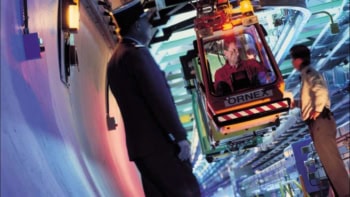Physics of the Impossible: A Scientific Exploration of the World of Phasers, Force Fields, Teleportation and Time Travel
Michio Kaku
2008 Allen Lane
£20.00/$26.95hb 352pp

Achieving the impossible might turn out to actually be impossible, but in the process of trying we can redefine the possible. It is the difference between ambition and complacency. Again and again — especially towards the end of the 19th century — complacent scientists have made future fools of themselves by proclaiming the impossibility of things such as determining the composition of stars or discovering the ultimate structure of matter. Ambitious authors, on the other hand, write books about “impossible” science. John Horgan tried with The End of Science, and John Barrow with Impossibility: The Limits of Science and the Science of Limits. Now the physicist and science communicator Michio Kaku offers us Physics of the Impossible.
Kaku has already given us one crystal ball with his book Visions: How Science Will Revolutionize the 21st Century and Beyond — aptly published in 1999 — which assessed the immediate future of computing, quantum physics and biomolecular science. Having explored these important frontiers, Kaku now focuses his sights much further ahead. Taking various examples from contemporary science fiction as a guide, he charts the possible future course of scientific and technological exploration.
The book, however, misses a good example of when science was actually influenced by fiction in this way. In Britain in the 1930s, while complacent politicians tried to appease the Nazi regime, imaginative scientists looked at the possibility of a high-energy electromagnetic-radiation weapon to zap enemy aircraft. They quickly found out that a radio wave “death ray” was impossible, but instead discovered an effective way of detecting planes using a technique that would eventually become known as radar.
Physics of the Impossible begins with force fields, which are firmly based in physics, and concludes with the similarly weighty topics of parallel universes, precognition and perpetual-motion machines. What comes in between, however, consists mainly of a menu of geeky technology — ray guns, starships, robots and so on — as well as a dose of telepathy and psychokinesis. So although physics is up there in the title, most of the physics content is confined to the final 100 of the book’s 350 pages.
A book about the impossible should point out that the quantum world already features plenty of “impossible” things, including time travel. Like embarrassing medical conditions, other puzzles and paradoxes of quantum physics used to be banished from view, but the graceful emergence of quantum entanglement from the fog of the Einstein—Podolsky—Rosen paradox, and the implications of the Aharonov—Bohm effect for nanoscience, have changed this. On the other hand, Schrödinger’s disreputable cat is still confined to a conceptual closet. Kaku lets it out and explores the possibility of reaching all kinds of “parallel universes”, where unfamiliar things happen. Elvis still lives in one such universe.
Quantum physics also points the way to achieving teleportation, which also once purely belonged to science fiction. Now photons — and even entire atoms — can be teleported across hundreds of metres. But Kaku remains ambivalent about whether we will ever be able to teleport on the macroscopic scale. The negative energy of the Casimir effect is another quantum peculiarity become fact. However, this force only operates under microscopic dimensions, which seems to rule out using it, or something like it, to drive spaceships carrying humans, not to mention the negative implications that such travel has for those on board.
Whatever the scientific potential of his topic, Kaku invariably turns to the human dimension, which injects pace into the book. Science has taught us, however, that the human scale is arbitrary and fragile. Just because we can think about these things does not mean that we have a privileged place in the universe. If Elvis lives, for example, any topological conduit to his parallel universe would be microscopically small or fiendishly uncomfortable, so Kaku’s dogged insistence on human involvement pushes many of his prospects out of reach.
A slight deficiency with the book is that Kaku includes little on the promising technology of smart materials, although they could be useful for accomplishing his goal of invisibility. Meanwhile, his treatment of custom-built biomolecules and nanobots — which could fight disease or tune physiology — is confined to psychokinesis: the ability to influence material objects using the mind. Looking beyond current technology, the author points out that hitherto reliable extrapolations like Moore’s law cannot continue forever, and replacements for silicon could open up scary new possibilities where computers could take over from people.
Although Kaku mainly sidesteps the grim implications of contemporary arms and weapons, his chapter on ray guns points out that a weapon taming the mechanism of astronomical gamma-ray bursters would make a terrestrial thermonuclear bomb look like a fizzle. An alien civilization could use one to completely wipe us out. But if he is concerned about the future of human civilization, Kaku should perhaps have looked at the possibilities of future science for the environment and climate change. What of the possibility of using physics to control the weather? That is surely more important than alien civilizations with cyborgs or phaser guns.
He also highlights tachyons — unorthodox particles that travel faster than light and that could have been responsible for fundamental mechanisms such as the primordial inflation of the Big Bang, or the Higgs effect, which endows particles with mass. While we are about it, why not also have creationist tachyons capable of producing a universe of astronomical dimensions within a biblical timescale?
On the whole, Kaku’s future physics is mainly a reductionist “bottom-up” synthesis, which ignores collective behaviour, such as superfluidity, that also surely has a message for the future. Each chapter predictably conforms to a template — an introduction based on Star Trek or some other convenient science fiction, the conjecture, and a final hook to the next chapter. Despite these shortcomings, however, Physics of the Impossible is a stimulating and entertaining read, underlining the need for know-all scientists to avoid smug complacency. It should really have been called “Science of the Impossible”, but that title has been pounced on elsewhere.



